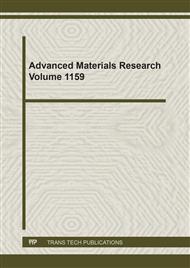[1]
S. Ahamad, Organic semiconductors for device applications: current trends and future prospects, Journal of Polymer Engineering. 34 (2014) 279- 338.
DOI: 10.1515/polyeng-2013-0267
Google Scholar
[2]
K. Kawano, J. Sakai, M. Yahiro, C. Adachi, Effect of solvent on fabrication of active layers in organic solar cells based on poly (3-hexylthiophene) and fullerene derivatives, Sol.EnergyMater.Sol.Cells. 93 (2009) 514–518.
DOI: 10.1016/j.solmat.2008.11.003
Google Scholar
[3]
M. Eslamian, Inorganic and Organic Solution- Processed Thin Film Device, Nano – Micro Letters. 9 (2017) 1-23.
Google Scholar
[4]
Krishna Feron, WarwickJ. Belcher, Christopher J. Fell, Paul C. Dastoor , Organic solar cells: understanding the role of fórster resonance energy transfer.. Int .J. Mol. Sci. 13 (2012) 17019–17047.
DOI: 10.3390/ijms131217019
Google Scholar
[5]
Travis L. Benanti, D. Venkataraman, Organic solar cells: an overview focussing on active layer morphology, Photosynth. Res. 87 (2006) 73–81.
DOI: 10.1007/s11120-005-6397-9
Google Scholar
[6]
S. Chakraborty, N. B. Manik, Effect of COOH-functionalized SWCNT addition on the electrical and photovoltaic characteristics of Malachite Green dye based photovoltaic cells, Journal of Semiconductors. 35 (2014) 124004(1-6).
DOI: 10.1088/1674-4926/35/12/124004
Google Scholar
[7]
D. P. Hagberg, T. Marinado, K. M. Karlsson, K. Nonomura, P. Qin, etc, Tuning the HOMO and LUMO energy levels of organic chromophores for dye sensitized solar cells, Journal of Organic Chemistry. 72 (2007) 9550–9556.
DOI: 10.1021/jo701592x
Google Scholar
[8]
M. Ikram, R. Murry, M. Imran, S. Ali, S.IsmatShah, Enhanced performance of P3HT/ (PCBM:ZnO:TiO2) blend based hybrid organic solar cells, Materials Research Bulletin. 75 (2016) 35-40.
DOI: 10.1016/j.materresbull.2015.11.031
Google Scholar
[9]
Aruna P. Wanninayake, Benjamin C. Church, and Nidal Abu-Zahra*, Effect of ZnO nanoparticles on the power conversion efficiency of organic photovoltaic devices synthesized with CuO nanoparticles, AIMS Materials Science. 3 (2016) 927-937.
DOI: 10.3934/matersci.2016.3.927
Google Scholar
[10]
M. Rani, S. K. Tripathi, A Comparative Study of Nanostructured TiO2, ZnO and Bilayer TiO2/ZnO Dye-Sensitized Solar Cells, Journal of Electronics Materials. 44 (2015) 1151- 1159.
DOI: 10.1007/s11664-015-3636-5
Google Scholar
[11]
Karimov. S. Khasan, Mahroof-Tahir. M, Saleem. M etc., I–V characteristics of vanadium-flavonoid complexes based Schottky diodes, Physica B. 406 (2011) 3011-3017.
DOI: 10.1016/j.physb.2011.04.068
Google Scholar
[12]
Z. Ahmad, M. H. Sayyad, Electrical characteristics of a high rectification ratio organic Schottky diode based on methyl red, Optoelectronics and Advanced Materials Rapid Communications. 3 (2009) 509 - 512.
Google Scholar
[13]
M. Shah, M. H. Sayyad, S. Kh. Karimov, Electrical characterization of the organic semiconductor Ag/CuPc/Au Schottky diode, Journal of Semiconductors. 32 (2011) 044001(1-5).
DOI: 10.1088/1674-4926/32/4/044001
Google Scholar
[14]
John A. Carr, S. Chaudhary, On the identification of deeper defect levels in organic photovoltaic devices, J.Appl.Phys. 114 (2013) 064509-7.
DOI: 10.1063/1.4818324
Google Scholar
[15]
S. M. H. Rizvi and B. Mazhari, Investigation of Traps in Thin-Film Organic Semiconductors Using Differential Analysis of Steady-State Current–Voltage Characteristics', IEEE Transactions on Electron Devices. 65 (2018) 3430 - 3437.
DOI: 10.1109/ted.2018.2849346
Google Scholar
[16]
A. Haldar, S. Maity, N. B. Manik., Electrical and photovoltaic characterisations of methyl red dye doped solid-state photoelectrochemical cell, Ionics. 15 (2009) 79–83.
DOI: 10.1007/s11581-008-0237-9
Google Scholar
[17]
S. Chakraborty, N. B. Manik, Effect of COOH-functionalized SWCNT addition on the electrical and photovoltaic characteristics of Malachite Green dye based photovoltaic cells, Journal of Semiconductors. 35 (2014) 124004(1-6).
DOI: 10.1088/1674-4926/35/12/124004
Google Scholar
[18]
A. Y. Khan, B. Saha, G. S. Kumar, Phenazinium dyes safranine O and phenosafranine induce self-structure in single stranded polyadenylic acid: Structural and thermodynamic studies, Journal of Photochemistry and Photobiology B: Biology. 132 (2014) 17-26.
DOI: 10.1016/j.jphotobiol.2014.01.014
Google Scholar
[19]
A. K. Jana, Solat cells based on dyes, Journal of Photochemistry and Photobiology A: Chemistry. 132 (2000) 1-17.
Google Scholar
[20]
M. Shah, Kh.S. Karimov, Z. Ahmad, M.H. Sayyad, Electrical characteristics of Al/CNT/NiPc/PEPC/Ag surface-type cell, Chin Phys. Lett. 27 (2010) 106102.
DOI: 10.1088/0256-307x/27/10/106102
Google Scholar
[21]
S. Okur, F. Yakuphanoglu, M. Ozsoz, P. Kara Kadayifcilar, Electrical and interface properties of Au/DNA/n-si organic-on-inorganic structures, Microelectron. 86 (2009) 2305-2311.
DOI: 10.1016/j.mee.2009.04.017
Google Scholar
[22]
M. Shah, M.H. Sayyad, Kh.S Karimov,F. Wahab, Electrical characterization of the ITO/NiPc/PEDOT : PSS junction diode, J. Appl. Phys. 43 (2010) 405104.
DOI: 10.1088/0022-3727/43/40/405104
Google Scholar
[23]
F. Yakuphanoglu, Controlling of silicon–insulator–metal junction by organic semiconductor polymer thin film, Synth. Met. 160 (2010) 1551-1555.
DOI: 10.1016/j.synthmet.2010.05.024
Google Scholar
[24]
F. Yakuphanoglu, M. Kandaz, B. F. Senkal, Inorganic–organic photodiodes based on polyaniline doped boric acid and polyaniline doped boric acid:nickel(II) phthalocyanine composite, Sensors & Actuators: A. Physical. 153(2009) 191-196.
DOI: 10.1016/j.sna.2009.05.008
Google Scholar
[25]
S. K. Cheung, N. W. Cheung, Extraction of Schottky diode parameters from forward current‐voltage characteristics, Applied Physics Letters. 49 (1986) 85-87.
DOI: 10.1063/1.97359
Google Scholar
[26]
M. Benhaliliba, Extracted electronic parameters of a novel Ag/Sno2: In/Si/Au Schottky diode for Solar cell application, Journal of Nano- and Electronic Physics. 7 (2015) 02029 (1-4).
Google Scholar


